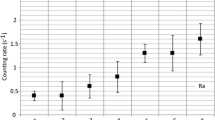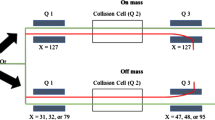Abstract
A rapid, accurate and less labor intensive approach to determining 226Ra in environmental samples was examined; this utilized quadrupole-based inductively coupled plasma mass spectrometry (ICP-QMS). The procedure used chemical separation by ion exchange chromatography to remove most of the matrices after coprecipitation with BaSO4. The average chemical recovery of the NIST SRM preparation method ranged from 60.5 to 85.9% using 133Ba as internal tracer by gamma counting. This technique was capable of completing a 226Ra measurement within 3 min. It did not require an in-growth period to allow radon and its progeny to achieve secular equilibrium with the parent 226Ra as is needed for liquid scintillation analyzer (LSA). The method detection limits for the determination of 226Ra in geothermal water and sediment samples were 0.02 mBq L−1 (0.558 fg L−1) and 0.10 Bq kg−1 (2.79 fg g−1), respectively. The results obtained with various natural samples and the suitability of the method when applied to various environmental matrices such as geothermal water and sediment are discussed. When ICP-QMS was compared to double-focusing magnetic sector field inductively coupled plasma mass spectrometry (ICP-SFMS), good agreement was obtained with a correlation coefficient, r 2 = 0.982.





Similar content being viewed by others
References
Eisenbud M (1973) Environmental adioactivity, 2nd edn. Academic Press, New York
Sill CW (1987) Determination of radium-226 in ores, nuclear wastes and environmental samples by high-resolution alpha spectrometry. Nucl Chem Waste Manage 7:239–256
Blanchard RK, Hahne RM, Kahn B, McCurdy D, Mellor RA, Moore MS, Sedlet J (1985) Radiological sampling and analytical methods for national primary drinking water regulations. Health Phys 48(5):587–600
Rama, Moore WS (1996) Using the radium quartet for evaluating groundwater input and water exchange in salt marshes. Geochim Cosmochim Acta 60(23):4645–4652
Erickson MD, Chieco NA, Isabel MF (1997) Radium-226 in soil, vegetation ash and ion exchange resin (Ra-03-RC, vol 1) and radium-226 in tap water, urine, and feces (Ra-04-RC, vol 1). The Procedures Manual of the Environmental Measurements Laboratory, HASL-300, 28th edn. US Department of Energy, New York
Kuo YC, Lai SY, Huang CC, Lin YM (1997) Activity concentrations and population dose from 226Ra food and drinking water in Taiwan. Appl Radiat Isot 48(9):1245–1249
Hassan NM, Ishikawa T, Hosoda M, Sorimachi A, Tokonami S, Masahiro F, Sahoo SK (2010) Assessment of the natural radioactivity using two techniques for the measurement of radionuclide concentration in building materials used in Japan. J Radioanal Nucl Chem 283:15–21
Gougang J, Torri G, Ocone R (2007) Determination of radium isotopes in soil samples by alpha-spectrometry. J Radioanal Nucl Chem 273:779–783
Rodríguez-Alvarez MJ, Sánchez F (1995) Measurement of radium and thorium isotopes in environmental samples by alpha-spectrometry. J Radioanal Nucl Chem 191:3–13
Alvarado JS, Orlandini KA, Erickson MD (1995) Rapid determination of radium isotopes by alpha spectrometry. J Radioanal Nucl Chem 194(1):163–172
Crespo MT, Jiménez AS (1997) On the determination of radium by alpha spectrometry. J Radioanal Nucl Chem 221:149–152
Currie LA (1968) Limits for qualitative detection and quantitative determination. Anal Chem 40(3):586–593
Aguado JL, Bolivar JP, García-Tenorio R (2008) 226Ra and 228Ra determination in environmental samples by alpha-particle spectrometry. J Radioanal Nucl Chem 278(1):191–199
Köhler M, Preuße W, Gleisberg B, Schäfer I, Heinrich T, Knobus B (2002) Comparison of methods for the analysis of 226Ra in water samples. Appl Radiat Isot 56:387–392
Dowdall M, Selnæs ØG, Gwynn JP, Davids C (2004) Simultaneous determination of 226Ra and 238U in soil and environmental materials by gamma-spectrometry in the absence of radium progeny equilibrium. J Radioanal Nucl Chem 261:513–521
Küsters M, Schraven W (2009) Determination and differentiation of 226Ra and 222Rn by gamma-ray spectrometry in drinking water. J Radioanal Nucl Chem 280:475–480
Mihai SA (2005) Sediment sample preparation for the determination of Pu and Am isotopes. J Radioanal Nucl Chem 266:259–264
Hodge VF, Laing GA (1994) An evaluation of the inductively coupled plasma mass spectrometer for the determination of radium-226 in drinking water. Radiochim Acta 64:211–215
Becker JS, Dietze HJ (1999) Application of double-focusing sector field ICP mass spectrometry with shielded torch using different nebulizers for ultratrace and precise isotope analysis of long-lived radionuclides. J Anal At Spectrom 14:1493–1500
XSeries II ICP-MS: π Extraction—designed to meet the most demanding applications for both conventional and collision cell ICP-MS, Thermo technical note-40717. http://www.thermo.com/eThermo/CMA/PDFs/Articles/articlesFile_24979.pdf
Decaillon JG, Bickel M, Hill C, Altzitzoglou T (2004) Validation of methods for the determination of radium in waters and soil. Appl Radiat Isot 61:409–413
Momoshima N, Nita J, Maeda Y, Sugihara S, Shinno I, Matsuoka N, Huang CW (1997) Chemical composition and radioactivity in hokutolite (plumbian barite) collected at Peito Hot Spring, Taiwan. J Environ Radioact 37(1):85–99
Chu TC, Wang JJ (2000) Radioactive disequilibrium of uranium and thorium nuclide series in hot spring and river water from Peitou Hot Spring Basin in Taipei. J Nucl Radiochem Sci 1:5–10
Lin CC, Chu TC, Huang YF (2003) Variations of U/Th-series nuclides with associated chemical factors in the hot spring area of northern Taiwan. J Radioanal Nucl Chem 258(2):281–286
Kim YJ, Kim CK, Kim CS, Yun JY, Rho BH (1999) Determination of 226Ra in environmental samples using high-resolution inductively coupled plasma mass spectrometry. J Radioanal Nucl Chem 240(2):613–618
Joannon S, Pin C (2001) Ultra-trace determination of 226Ra in thermal waters by high sensitivity quadrupole ICP-mass spectrometry following selective extraction and concentration using radium-specific membrane disks. J Anal At Spectrom 16:32–37
Hadad K, Doulatdar R (2008) U-series concentration in surface and ground water resources of Ardabil Province. Radiat Prot Dosimetry 130(3):309–318
Cevik U, Damla N, Karahan G, Celebi N, Kobya AI (2006) Natural radioactivity in tap waters of Eastern Black Sea region of Turkey. Radiat Prot Dosimetry 118:88–92
Godoy JM, Godoy ML (2006) Natural radioactivity in Brazilian groundwater. J Environ Radioact 85(1):71–83
Chen CC, Lin PH, Huang CC (2005) High background radiation valley formed by Peitou Hot Spring. Int Congr Ser 1276:315–316
Labidi S, Dachraoui M, Mahjoubi H, Lemaitre N, Salah RB, Mtimet S (2002) Natural radioactive nuclides in some Tunisian thermo-mineral springs. J Environ Radioact 62:87–96
Herczeg AL, Simposon HJ, Anderson RF (1988) Uranium and radium mobility in groundwaters and brines within the Delaware Basin, Southeastern New Mexico. Chem Geol 72:181–196
Lozano JC, Rodríguez PB, Tomé FV (2002) Distribution of long-lived radionuclides of the 238U series in the sediments of a small river in a uranium mineralized region of Spain. J Environ Radioact 63:153–171
El Mamoney MH, Khater AEM (2004) Environmental characterization and radio-ecological impacts of non-nuclear industries on the Red Sea coast. J Environ Radioact 73:151–168
Akram M, Qureshi RM, Ahmad N, Solaija TJ (2006) Gamma-emitting radionuclides in the shallow marine sediments off the Sindh coast, Arabian sea. Radiat Prot Dosimetry 118(4):440–447
Pointurier F, Hubert A, Baglan N (2008) Evaluation of a new generation quadrupole-based ICP-MS for uranium isotopic measurements in environmental samples. J Radioanal Nucl Chem 276(2):505–511
Acknowledgements
The authors would like to thank Mr. Ching-Ho Yang and Mr. Ruei-Sheng Chang of Institute of Nuclear Energy Research for their technical assistance. Dr. Gia-Luen Guo is gratefully acknowledged for providing analysis references and his encouragement throughout the work. Many thanks to Mr. Reed Chiang, Miss Vicki Wu, Mr. Simon Tai and Mr. Fox Yang from Thermo-Electron technical support group of Joy Allied Technology Corp. in Taiwan for their help and suggestions that kept the ICP-QMS operational and maintained the instrument at a high level of performance.
Author information
Authors and Affiliations
Corresponding author
Rights and permissions
About this article
Cite this article
Tsai, TL., Lin, CC., Wang, TY. et al. Application of ICP-QMS for the determination of ultratrace-levels of 226Ra in geothermal water and sediment samples. J Radioanal Nucl Chem 286, 145–154 (2010). https://doi.org/10.1007/s10967-010-0625-2
Received:
Published:
Issue Date:
DOI: https://doi.org/10.1007/s10967-010-0625-2




